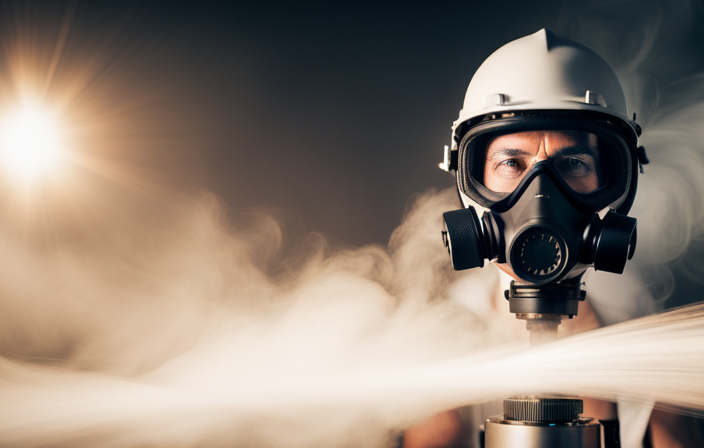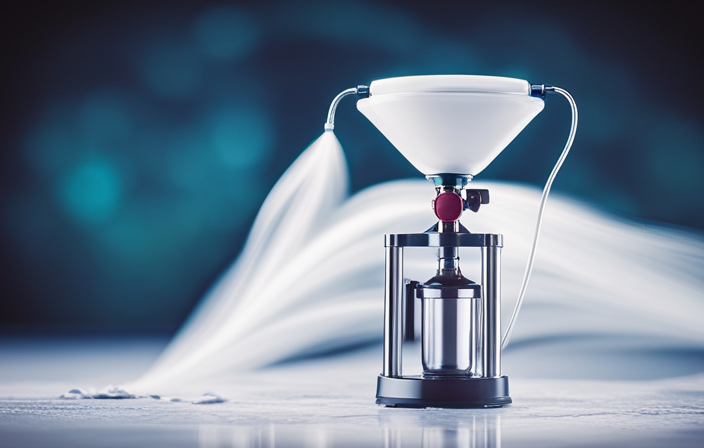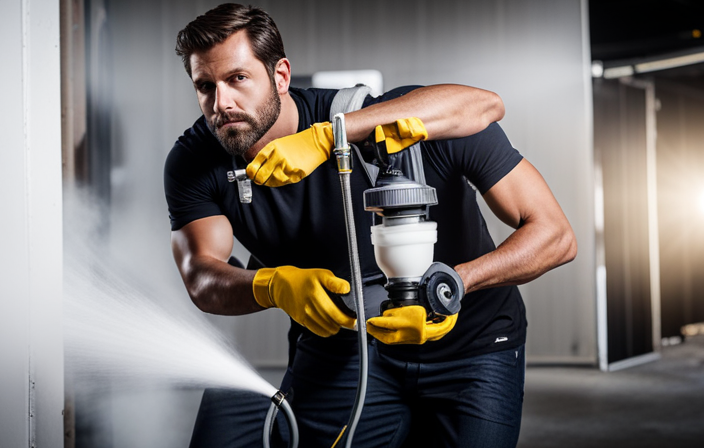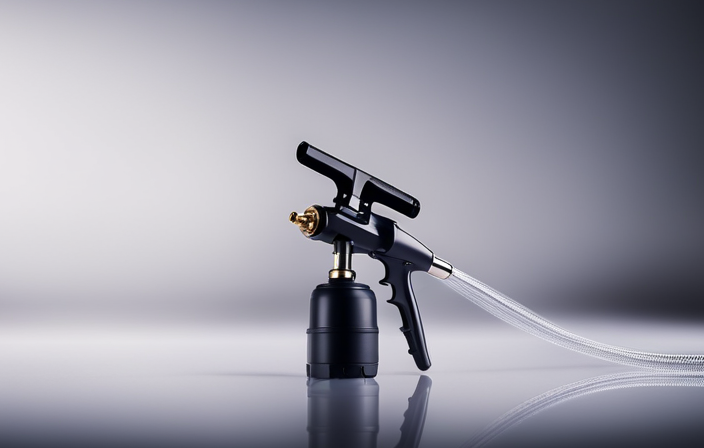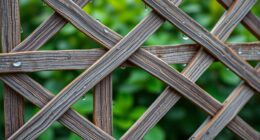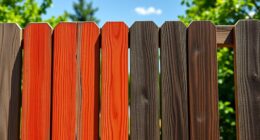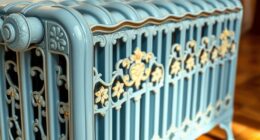As a DIY enthusiast, I have always been drawn to projects that allow me to personalize my living space. Often overlooked in home decorating projects, closet interiors play a crucial role in the overall look of a room.
That’s why I am excited to share with you my knowledge and expertise on how to paint inside closets using an airless paint sprayer. In this article, I will guide you through the necessary steps to prepare the closet, choose the right paint and equipment, and practice proper safety measures.
With a test spraying under your belt, you’ll be ready to confidently paint the closet and achieve professional-looking results. So, let’s dive in and bring new life to those neglected closets!
Key Takeaways
- Prepare the closet by removing all items, cleaning the walls, and filling in cracks or holes.
- Choose the right paint and equipment, such as high-quality paint suitable for closets and an airless paint sprayer with the right nozzle size.
- Gather other necessary painting supplies like a paintbrush, painter’s tape, and drop cloths.
- Practice proper safety measures by wearing protective gear, ensuring ventilation, and taking precautions against inhaling paint particles or chemicals.
Prepare the Closet for Painting
Before you start painting, make sure to remove all items from the closet to create a clear and clean space. This will prevent any accidental paint splatters or damage to your belongings.
Once the closet is empty, you can begin preparing the walls for painting. Start by cleaning the walls thoroughly to remove any dirt, dust, or grease. Use a mild detergent and a sponge or cloth to wipe down the walls.
After cleaning, inspect the walls for any imperfections such as cracks or holes. Fill in these imperfections with spackle or putty and allow it to dry completely. Sand the patched areas lightly to create a smooth surface for painting.
With the closet walls prepped, you can now move on to choosing the right paint color and equipment for the job.
Choose the Right Paint and Equipment
To ensure a successful closet painting project, it’s crucial to select a high-quality paint that’s suitable for the job. Look for a paint that’s specifically designed for interior use and has good coverage and durability.
Additionally, I recommend getting an airless paint sprayer with the right nozzle size to achieve a smooth and even finish.
Lastly, don’t forget to gather other necessary painting supplies such as drop cloths, painter’s tape, and brushes or rollers.
Select a high-quality paint suitable for closets
When you’re preparing to paint the inside of a closet with an airless paint sprayer, it’s crucial to choose a top-notch paint that will effortlessly transform the space into a stunning masterpiece. Here are four important considerations when selecting a high-quality paint suitable for closets:
-
Paint brand recommendations: Opt for well-known brands that offer durability and excellent coverage. Brands like Sherwin-Williams and Benjamin Moore have a wide range of options specifically designed for small spaces like closets.
-
Tips for painting in small spaces: Look for paints with low odor and quick drying time to minimize any inconvenience. Also, consider using a paint with built-in primer to save time and effort.
-
Consider the finish: For closets, a semi-gloss or satin finish is recommended as they are easier to clean and provide a smooth, attractive appearance.
-
Test samples: Before committing to a specific paint, try out sample pots on a small area inside the closet to ensure you’re satisfied with the color and finish.
Now that you have the perfect paint in mind, let’s move on to the next step: getting an airless paint sprayer with the right nozzle size.
Get an airless paint sprayer with the right nozzle size
Now that you’ve found the perfect paint, it’s time to equip yourself with an airless paint sprayer that has the ideal nozzle size. Choosing the right nozzle size is crucial for achieving a smooth and even finish when painting inside closets. Here are some tips for selecting the right nozzle size for different painting projects:
| Nozzle Size | Recommended Use | Coverage |
|---|---|---|
| 0.011 | Trim and detail work | 4-6 inches |
| 0.015 | Cabinets and small rooms | 6-8 inches |
| 0.017 | Walls and larger surfaces | 8-12 inches |
Using an airless paint sprayer for interior painting has several benefits. Firstly, it provides faster and more efficient coverage compared to traditional methods like brushes or rollers. Additionally, it allows for a more even application, reducing the chances of streaks or brush marks. Lastly, it enables you to reach tight corners and crevices, ensuring complete coverage in every nook and cranny.
Now that you have the right paint and an airless paint sprayer with the ideal nozzle size, it’s time to gather other necessary painting supplies.
Gather other necessary painting supplies
Equip yourself with all the essential tools and supplies needed to transform your space into a work of art. Here are three items you’ll need to ensure a successful painting project:
-
A high-quality paintbrush: This will help you achieve precise edges and corners, especially in tight spaces like closets.
-
Painter’s tape: Use this to protect areas that you don’t want to be painted, such as door frames or shelves.
-
Drop cloths: Lay them down to protect the floor and any items you can’t remove from the closet.
Choosing the right paint color is crucial for creating the desired atmosphere in your closet. Consider the mood you want to evoke and the overall aesthetic of your space. Additionally, preparing the surface properly is essential for a smooth and long-lasting finish. Clean the walls thoroughly, remove any peeling paint or wallpaper, and repair any imperfections.
Once you have all the necessary supplies and have chosen your paint color, it’s time to practice proper safety measures when using an airless paint sprayer.
Practice Proper Safety Measures
Make sure you’re taking all the necessary precautions and wearing protective gear, like a mask and goggles, before you start painting inside closets with an airless paint sprayer. Isn’t your safety the top priority? When it comes to painting, safety precautions should never be overlooked. Proper ventilation is crucial to ensure the harmful fumes from the paint don’t accumulate in the confined space. Additionally, wearing protective gear, such as goggles and masks for respiratory protection, is essential to prevent any potential health risks from inhaling paint particles or chemicals. Remember, taking these safety measures will not only protect you but also create a more enjoyable painting experience. So, now that we’ve covered the importance of safety, let’s move on to the next step: starting with a test spraying.
Start with a Test Spraying
Before you begin, it’s crucial to start with a quick test spray to ensure the perfect application. Test spraying techniques are essential to determine the right settings for your airless paint sprayer.
Start by adjusting the pressure and nozzle size according to the paint manufacturer’s recommendations. Then, aim the sprayer at a piece of cardboard or scrap material and spray a small area. Check for any issues such as uneven coverage, drips, or clogs. Troubleshooting common issues during the test spray will save you time and frustration later on.
Once you are satisfied with the results, you can confidently begin painting the closet. Remember to maintain a consistent distance from the surface and use smooth, overlapping strokes for an even finish.
Begin Painting the Closet
To begin painting the closet, I recommend starting from the top and working your way down. This ensures that any drips or splatters will be covered as you continue painting.
It’s also important to maintain a consistent distance from the surface, typically around 6 to 8 inches, to achieve an even coat of paint.
Lastly, remember to apply thin and even coats of paint to avoid any clumping or streaking.
By following these key points, you’ll be able to effectively paint the inside of your closet with an airless paint sprayer.
Start from the top and work your way down
When painting inside closets with an airless paint sprayer, it’s essential to begin at the top and work your way down, ensuring an even and thorough coat of paint. Starting from the top allows the paint to flow smoothly and avoids any drips or streaks on already painted surfaces. Here are some tips for painting narrow spaces:
- Choosing the right paint color: Consider using light colors to make the closet appear larger and brighter.
- Clear the space: Remove all items from the closet to prevent them from getting paint on them.
- Prep the surface: Clean the walls and patch any holes or imperfections before painting.
- Use a small brush for edges: A small brush can help you paint the corners and edges with precision.
- Tape off areas: Use painter’s tape to protect areas you don’t want to get paint on.
By starting at the top and working your way down, you’ll ensure a professional finish. Maintaining a consistent distance from the surface is the next step for achieving a flawless paint job.
Maintain a consistent distance from the surface
As you glide the tool along, keep a steady hand and maintain a consistent distance from the walls, almost as if you were effortlessly dancing with the surface.
Maintaining distance is crucial when using an airless paint sprayer inside closets. This ensures that the paint is applied evenly and prevents overspray from reaching unwanted areas. By maintaining a steady distance, you can control the coverage and achieve professional-looking results.
It is recommended to keep the sprayer nozzle approximately 12 inches away from the closet walls. This distance allows for an optimal spray pattern and helps avoid excessive paint build-up or drips. Remember to adjust your distance based on the specific requirements of your paint sprayer model.
By following this technique, you can avoid overspray and achieve a uniform finish.
Now, let’s move on to the next step and learn how to apply thin and even coats of paint.
Apply thin and even coats of paint
You can achieve a flawless finish by ensuring that each coat of paint is applied thinly and evenly. Applying multiple thin coats is key to avoiding paint drips and achieving a professional-looking result. By doing so, you can prevent the paint from pooling and creating uneven surfaces. To help you visualize the importance of applying thin and even coats of paint, take a look at the table below:
| Coat Number | Thickness (mil) | Result |
|---|---|---|
| 1 | 2 | Uneven |
| 2 | 4 | Better |
| 3 | 6 | Flawless |
As you can see, each subsequent coat builds upon the previous one, gradually creating a smooth and flawless finish. By applying thin coats, you can also ensure faster drying times, allowing you to move on to the next coat sooner. Now, let’s move on to the next section and discuss how paying attention to detail can further enhance your painting results.
Pay Attention to Detail
When using an airless paint sprayer, it is important to pay attention to detail in order to achieve a professional-looking finish. One crucial aspect to consider is the lighting in your closet. Make sure you have adequate lighting to see all the nooks and corners that need to be painted. This will help you identify any missed spots or uneven coverage.
Another important detail to focus on is color coordination. Choose a paint color that complements the overall design of your closet and enhances the space. Coordinating the color with the rest of the room will create a cohesive and polished look.
Remember to allow sufficient drying time before moving on to the next step. This will ensure a flawless and long-lasting paint job.
Allow Sufficient Drying Time
When it comes to allowing sufficient drying time for paint inside closets, it is crucial to follow the paint manufacturer’s instructions. These instructions will provide specific guidelines on how long the paint needs to dry before it is fully cured.
Additionally, it is important to keep the closet well-ventilated during the drying process to help speed up the drying time and prevent any potential odor buildup.
Lastly, it is essential to avoid touching the painted surfaces until they are fully dry to ensure a smooth and flawless finish.
Follow the paint manufacturer’s instructions for drying time
After applying the final coat of paint, it’s important to adhere to the paint manufacturer’s instructions for drying time. Proper drying time is crucial to achieve a durable and professional-looking finish. The paint manufacturer’s instructions will provide specific guidelines for how long the paint needs to dry before it is considered fully cured.
During the drying process, it is important to ensure proper ventilation in the closet. This will help to speed up the drying time and prevent any potential damage to the painted surfaces. To keep the closet well-ventilated, consider keeping the closet door open and using fans or opening windows to promote air circulation. This will aid in the drying process and ensure a successful paint job.
Transitioning into the next section about keeping the closet well-ventilated during the drying process, it’s also important to take precautions to prevent dust or debris from settling on the painted surfaces.
Keep the closet well-ventilated during the drying process
To ensure a successful and efficient drying process, you’ll want to make sure the closet is well-ventilated. This is crucial to prevent paint fumes from accumulating and causing discomfort or health issues. Open up any windows or doors in the closet, and if possible, use fans or air purifiers to enhance airflow. This will help the paint dry quicker and minimize the time you have to wait before using the closet again.
Once the paint is applied, it’s important to avoid touching the painted surfaces until fully dry. This will prevent any smudging or damage to the finish.
Avoid touching the painted surfaces until fully dry
Make sure you resist the temptation to run your fingers along the freshly painted walls until they are completely dry, as this could ruin the smooth finish you worked so hard to achieve. To ensure the best results, it is essential to provide proper ventilation inside the closet during the drying process. This will help the paint dry more efficiently and prevent any unpleasant odors from lingering.
Additionally, here are some tips to prevent smudges and fingerprints on your newly painted surfaces:
- Avoid leaning any objects or clothing against the walls until fully dry.
- Use caution when opening and closing doors to prevent accidental contact.
- Consider using temporary protective coverings, such as plastic sheets or drop cloths, to shield the painted surfaces.
- If you must handle any items inside the closet, wear clean gloves to minimize the risk of leaving marks.
By following these guidelines, you can ensure a flawless finish.
Now, let’s move on to evaluating the results of your painting project.
Evaluate the Results
Once the paint has dried, you’ll be able to fully appreciate the smooth and even finish that the airless paint sprayer has achieved inside the closets.
To evaluate durability, carefully inspect the painted surfaces for any signs of chipping, peeling, or cracking. Run your fingers over the paint to feel for any roughness or imperfections.
Assess color accuracy by comparing the painted surfaces to the desired color or sample swatch. Look for any variations or inconsistencies in color tone.
If you are satisfied with the results, it’s time to move on to the next step of clean and maintain your paint sprayer. Proper maintenance ensures the longevity and efficiency of your equipment, allowing you to tackle future painting projects with ease.
Clean and Maintain Your Paint Sprayer
After finishing a painting project, it’s crucial to thoroughly clean the paint sprayer. This will ensure its optimal performance for future use. Properly storing the equipment is also essential in preventing any damage or clogging.
To prolong the lifespan of the paint sprayer, it’s important to follow the maintenance guidelines provided by the manufacturer.
Thoroughly clean the paint sprayer after use
To ensure proper maintenance, it’s essential to thoroughly clean the paint sprayer after each use when painting inside closets with an airless paint sprayer. Properly cleaning the sprayer will prolong its lifespan and ensure optimal performance for future projects. Here is a step-by-step guide to help you through the cleaning process:
-
Start by disconnecting the sprayer from the power source and relieving any pressure in the system.
-
Remove the spray tip and guard, then clean them thoroughly with warm soapy water. Use a brush to remove any dried paint residue.
-
Flush the sprayer with clean water to remove any remaining paint. You can use a bucket or a flushing solution recommended by the manufacturer.
-
Finally, reassemble the sprayer and store it properly to prevent damage.
By following these maintenance tips and cleaning the paint sprayer diligently, you’ll ensure its longevity and be ready for your next painting project.
Store the equipment properly to prevent damage
Make sure you store your valuable tool in a safe and secure place, protecting it from potential harm and ensuring it’s ready whenever you need it.
Proper equipment storage is crucial to prevent damage and maintain the quality of your airless paint sprayer. After cleaning, make sure to remove any excess paint and ensure all parts are dry before storing.
Store the sprayer in a clean and dry area, away from extreme temperatures, direct sunlight, and moisture. It’s a good idea to keep it in its original case or box, if available, to provide an added layer of protection.
Regularly inspect the sprayer for any signs of damage or wear and tear, and address any issues immediately. By following proper equipment storage practices, you can prolong the sprayer’s lifespan and ensure it continues to function optimally.
Follow maintenance guidelines to prolong the sprayer’s lifespan
To ensure the longevity of your airless paint sprayer, it’s crucial to follow proper maintenance guidelines. Regular maintenance is important in preserving the functionality and performance of your sprayer. Here are three essential steps to keep in mind:
-
Clean the sprayer thoroughly after each use to prevent paint residue from clogging the nozzle and causing damage.
-
Inspect and replace any worn or damaged parts promptly to avoid potential issues during your next painting task.
-
Lubricate the sprayer’s moving parts regularly to keep them running smoothly and prevent unnecessary wear and tear.
By adhering to these maintenance practices, you can prevent common mistakes and ensure that your airless paint sprayer lasts for years to come.
Now that you understand the importance of sprayer maintenance, let’s move on to the next section and discover how to enjoy your newly painted closets.
Enjoy Your Newly Painted Closets
Once the painting is complete, it’s time to organize and return items to the closet, making it functional and clutter-free.
As I step back and admire the fresh and professional-looking paint job, I can’t help but feel a sense of accomplishment and satisfaction.
I’m excited to share my success and newfound painting technique with others, knowing that I have achieved a high-quality finish that will stand the test of time.
Organize and return items to the closet
Now it’s time to sort through and put everything back in the closet, creating a sense of order and satisfaction.
After painting the inside of your closets with an airless paint sprayer, it’s important to take a moment to maximize the space and declutter.
Start by removing all items from the closet and organizing them into categories. This will allow you to assess what you have and determine what you need to keep, donate, or discard.
Consider using storage solutions such as bins, shelves, or hanging organizers to make the most of the closet’s space.
Once everything is sorted and organized, carefully return each item to its designated spot.
Admire the fresh and professional-looking paint job as you put the finishing touches on your newly transformed closet.
Admire the fresh and professional-looking paint job
As you step back and take in the sight of your newly transformed closet, you can’t help but feel a sense of awe at the fresh and profesh paint job. Using an airless paint sprayer for painting your closet offers numerous benefits. Firstly, it provides a faster and more efficient way of applying paint, saving you time and effort. The airless spray technology ensures a smooth and even finish, giving your closet a professional look. Secondly, with the right technique, you can achieve a flawless result. Start by preparing the surface properly, ensuring it is clean and smooth. Use smooth, continuous strokes while spraying, and maintain a consistent distance from the surface. Lastly, practice makes perfect, so don’t be afraid to experiment and refine your technique. With your newfound painting skills, you can now proudly share your success and inspire others to try this efficient method.
Share your success and newfound painting technique with others
Impress your friends and family with your newly acquired painting skills and share the secret behind your flawless and professional-looking closet transformation.
Painting inside closets can be a challenging task, but with the right techniques and troubleshooting tips, you can achieve outstanding results.
Start by preparing the surface properly, ensuring it is clean and smooth. Use painter’s tape to protect any areas you don’t want to be painted.
When using an airless paint sprayer, hold the nozzle at a consistent distance from the surface and move in a steady back-and-forth motion. Avoid spraying too much paint at once to prevent drips and runs.
If you encounter any issues, such as clogged nozzles or uneven coverage, consult the user manual for troubleshooting tips.
By sharing your success and newfound painting technique with others, you can inspire and help them achieve professional-looking results too.
Frequently Asked Questions
Can I use a regular paintbrush or roller instead of an airless paint sprayer to paint inside my closets?
Using a regular paintbrush or roller instead of an airless paint sprayer can be a good alternative for painting inside closets. Pros include better control and less overspray, but it may take longer to complete the job.
How long should I wait before placing my clothes and other items back into the closet after painting?
After painting a closet, it’s important to wait at least 24 hours before putting clothes and other items back in. To prepare a closet before painting, remove everything and clean the surfaces. When organizing after painting, categorize items and use storage solutions for better organization.
Can I paint over old paint or do I need to remove it before using the airless paint sprayer?
You can paint over old paint if it is in good condition and properly prepped. Sanding and cleaning the surface are important preparation methods. For example, I painted over old paint in my living room with great results.
Is it necessary to cover the floor and surrounding area with drop cloths or can I just rely on the sprayer’s control?
I recommend using drop cloths for floor protection, even with a paint sprayer’s control. While the sprayer can minimize overspray, it’s always better to be safe and prevent any accidental paint splatters on the floor and surrounding area.
Are there any specific safety measures I should take when using an airless paint sprayer inside a small, enclosed space like a closet?
When using an airless paint sprayer in a small enclosed space like a closet, it is crucial to prioritize safety precautions. Ensure proper ventilation by opening windows or using fans to prevent fumes from accumulating.
Conclusion
In conclusion, painting inside closets with an airless paint sprayer can be a time-saving and efficient way to transform your space. By following the proper steps and safety measures, you can achieve professional-looking results.
Did you know that using an airless paint sprayer can save you up to 50% of your painting time compared to using traditional brushes or rollers? This statistic highlights the effectiveness and convenience of using this tool.
So go ahead, give it a try, and enjoy the satisfaction of beautifully painted closets.

